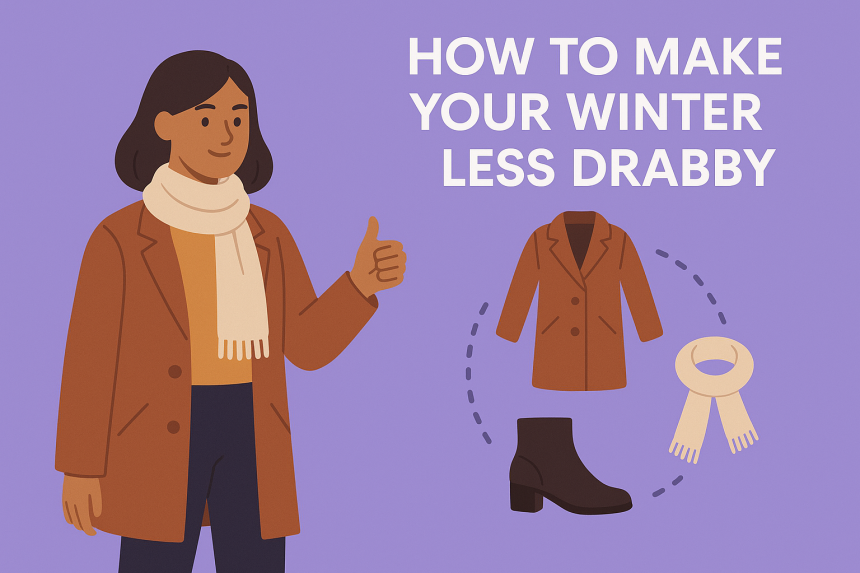Winter has a habit of flattening personal style. Between bulky coats, muted palettes, and the general desire to stay warm rather than stylish, it’s easy to feel like your wardrobe has slipped into hibernation. But winter doesn’t have to be a season of sartorial surrender. With a little intention, even the darkest, chilliest days can be an excuse to experiment, layering textures and adding details that keep you feeling sharp instead of stuck in a rut. Style thrives when it meets constraint, and cold weather gives you plenty to play with.
Color That Doesn’t Shout but Speaks
Neutrals dominate winter wardrobes because they’re safe, practical, and endlessly mixable. The problem is, too much gray, black, and beige stacked together can dull the mood before you’ve had your first coffee. You don’t need to leap into neon territory to change the vibe. Small doses of color, slipped into the everyday, carry more weight than an all-over statement. A rich emerald scarf against a camel coat or a pair of wine-colored leather gloves with a navy blazer can shift the tone entirely. Jewel tones in particular thrive in the colder months because they feel deep and grounded while still offering life. Even the subtlest swap—trading black trousers for a pair in dark burgundy—gives enough lift without compromising elegance. Think of color as seasoning. You don’t dump the whole jar, you add just enough to make the dish memorable.
Accessories That Carry the Weight
Winter clothing leans heavily toward heavy fabrics, so accessories aren’t just add-ons, they’re visual punctuation. The right bag, belt, or pair of earrings can rewrite the tone of an outfit that might otherwise disappear into the subway crowd. Cold-weather dressing benefits from shine, which is why luxury jewelry feels especially right in winter. A single oversized ring or gold chain bracelet poking out from a sleeve has more presence when the rest of the look is wrapped in wool and cashmere. Belts also play an underrated role this time of year. Cinching a coat at the waist with leather that isn’t the one it came with instantly makes the whole ensemble feel intentional. And never underestimate the power of a good hat. A beanie in ribbed cashmere can be minimal and chic, while a structured beret tilts the whole look toward Paris without trying too hard. Accessories don’t just decorate winter outfits, they redirect them.
Texture As a Silent Statement
When daylight fades by midafternoon, texture takes on the role color often plays in spring. Pile on different fabrics and the outfit becomes interesting before you’ve even left the mirror. Smooth leather against chunky knits, glossy satin under matte wool, or even a touch of shearling peeking out from a jacket collar breaks the monotony. Texture is also practical. Corduroy trousers retain warmth better than denim while giving a softer visual line. Velvet works beautifully in winter because it reflects light in subtle ways, lifting even the most understated palette. A suede bag paired with a glossy patent shoe creates depth without feeling busy. These combinations keep the outfit alive even when you’ve layered three or four pieces. Winter gives permission to stack fabrics in ways that would feel heavy in July, so it’s the season to go for it.
Shoes That Wake Up the Outfit
Coats get most of the attention in winter, but shoes do just as much heavy lifting when it comes to preventing an outfit from sinking into monotony. Boots are obvious, but within that category lives an entire vocabulary of style. Sleek Chelsea boots paired with trousers communicate differently than slouchy knee-highs tucked over denim. Where things get really interesting is when you step slightly outside the expected. That’s where mule shoes come into play. They’re not the first style you think of when temperatures drop, yet paired with tights or thick socks, they can create a sharp contrast against heavy layers up top. A polished mule with a small heel can instantly modernize wide-leg trousers, while a flat, furry-lined version softens a look without veering into slipper territory. Even sneakers, if chosen in leather or suede, can carry a winter outfit beyond the utilitarian. Footwear sets the pace of an outfit, and when it refuses to be predictable, everything else follows suit.
Layering That Actually Works
Most people approach layering as survival—how many sweaters can I wear under this coat before I can’t move my arms? The better way to think about it is architectural. The order in which you stack pieces matters, and when done right, layering isn’t just practical, it’s visually sharp. Start with something that has character on its own, whether it’s a patterned turtleneck or a silk blouse. Add a mid-layer that introduces contrast in fabric or cut—maybe a vest or cropped cardigan. Top it with an outer layer that ties it together without smothering what’s underneath. Playing with lengths matters too. A longer shirt hem that peeks out from under a shorter sweater creates dimension. Scarves can be treated as layers rather than afterthoughts, draped open instead of tied, so they act more like an elongated vest. The key is to build in a way that each layer can hold its own, not just disappear into insulation. When each piece contributes something unique, the whole outfit feels deliberate instead of defensive.
Pulling It All Together
The cold months don’t have to drain the life out of your wardrobe. They can just as easily become the time when your style sharpens. Color, accessories, texture, shoes, and layering aren’t separate fixes but threads that weave together, shifting winter dressing from necessity to expression. The simplest tweak—a scarf in sapphire, a coat belted with something unexpected, a pair of mules with tailored trousers—can make the difference between an outfit that feels routine and one that actually lifts your mood. Dressing well in winter isn’t about ignoring the cold, it’s about working with it and finding the small details that make every layer count.
Lynn Martelli is an editor at Readability. She received her MFA in Creative Writing from Antioch University and has worked as an editor for over 10 years. Lynn has edited a wide variety of books, including fiction, non-fiction, memoirs, and more. In her free time, Lynn enjoys reading, writing, and spending time with her family and friends.















